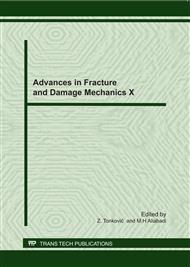p.85
p.89
p.93
p.97
p.101
p.105
p.109
p.113
p.117
Rolling Contact Fatigue Crack Growth Prediction by the Asperity Point Load Mechanism
Abstract:
The crack path and growth life of surface initiated rolling contact fatigue was investigated numerically based on the asperity point load mechanism. Data for the simulation was captured from a gear contact with surface initiated rolling contact fatigue. The evolvement of contact parameters was derived from an FE contact model where the gear contact had been transferred to an equivalent contact of a cylinder against a plane with an asperity. Crack propagation criteria were evaluated with practically identical crack path predictions. It was noted that the trajectory of largest principal stress in the uncracked material could be used for the path prediction. The mode I fracture mechanism was applicable to the investigated rolling contact fatigue cracks. The simulated path agreed with the spall profile both in the entry details as in the overall shape, which suggested that the point load mechanism was valid not only for initiation but also for rolling contact fatigue crack growth. Different equivalent stress intensity factor ranges were used to estimate the fatigue life, which agreed with the life of the investigated gear wheels.
Info:
Periodical:
Pages:
101-104
Citation:
Online since:
September 2011
Authors:
Price:
Сopyright:
© 2012 Trans Tech Publications Ltd. All Rights Reserved
Share:
Citation:


